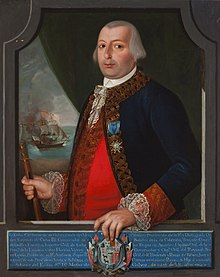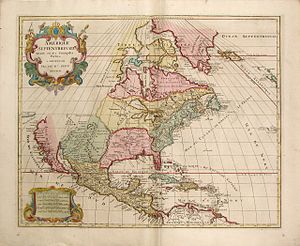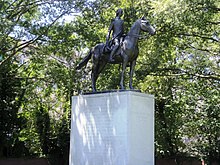Bernardo de Gálvez
While governor of Louisiana, he supported the colonists and their French allies in the American Revolutionary War, helping facilitate vital supply lines and frustrate British operations in the Gulf Coast.[2] He was granted many titles and honors by the Spanish government, which in 1783 appointed him viceroy of one of its most valuable territories, New Spain, succeeding his father Matías de Gálvez y Gallardo.[3] Gálvez Day is celebrated as a local holiday in Pensacola, and several places bear his name, including Galveston, Texas and Galvez, Louisiana.Gálvez was transferred to Seville in 1775, and then participated in Alejandro O'Reilly's disastrous expedition to Algiers, where he was seriously wounded during the Spanish assault on the fortress that guarded the city.[30] In December 1776, King Charles III of Spain decided that covert assistance to the United States would be strategically useful, but Spain did not enter into a formal alliance with the U.S.[31] In 1777, José de Gálvez, newly appointed as minister of the Council of the Indies, sent his nephew, Bernardo de Gálvez, to New Orleans as governor of Luisiana with instructions to secure the friendship of the United States.These included securing from Vice-Admiral Sir Peter Parker as many fighting ships as the fleet at Jamaica could spare,[46] gathering all forces in the province that could be assembled, recruiting as many loyal Indians as the Superintendent could provide,[47] and drawing on His Majesty's Treasury through the Lords Commissioners to pay expenses.After reading the communication from King George III and Germain, Gálvez, as Governor of Louisiana, swiftly and secretly mobilized the territory for war.[49] Gálvez carried out a masterful military campaign and defeated the British colonial forces at Fort Bute, Baton Rouge, and Natchez in 1779.[50][51] The Battle of Baton Rouge, on 21 September 1779, freed the lower Mississippi Valley of British forces and relieved the threat to the capital of Louisiana, New Orleans.Gálvez helped advance science in the colony by sponsoring the Royal Botanical Expedition to New Spain, led by Martín Sessé y Lacasta.[88] In his "Instructions", Gálvez advocated a policy of selling the Indians rifles and trade goods to make them dependent on the Spanish government,[89] and sanctioned war against the Apache if these inducements failed to pacify them.[92] The Cabildo, a branch of the Louisiana State Museum located on Jackson Square in New Orleans, has a portrait of General Gálvez accompanied by a display of biographical information.Spanish Plaza, in the Central Business District of the city, has an equestrian statue of Gálvez adjacent to the New Orleans World Trade Center.[95] In Baton Rouge, Louisiana (present-day state capital), Galvez Plaza is laid out next to City Hall and used frequently as a site for municipal events.[96] Also, the 13-story Galvez Building is part of the state government's administrative office-building complex in the Capitol Park section of downtown Baton Rouge.










Spanish namesurnameThe Most ExcellentField MarshalViceroy of New SpainCharles IIIMatías de Gálvez y GallardoAlonso Núñez de Haro y PeraltaSpanish Governor of LouisianaLuis de UnzagaEsteban Rodríguez MiróMacharaviayaTacubaya DistrictMexico CityNew SpainSpanish EmpireOrder of Charles IIIHonorary American CitizenshipSpanish ArmyCaptain GeneralMarshalSpanish Invasion of PortugalInvasion of AlgiersAmerican Revolutionary WarCapture of Fort ButeBattle of Baton RougeBattle of Fort CharlotteSiege of PensacolaSpanish military leadergovernment officialcolonial governorSpanish LouisianaViceroycareer soldierconquering West FloridaTreaty of ParisCapitoltyphusPensacolaGalveston, TexasGalvez, Louisianahonorary U.S. citizenshipprovince of MálagaMatías de Gálvezmilitary sciencesÁvilacaptured AlmeidalieutenantcaptainApachesNueva VizcayaSonoraJosé de GálvezFrenchSevilleAlejandro O'Reillyexpedition to Algiersprofessorlieutenant colonelFrench province of LouisianaLouisiana PurchaseFranceFloridaBritainSeven Years' WarGilbert Antoine de Saint-Maxenthigh ranking French colonial officialGeorge WashingtonGalvez TownNueva IberiaYucatánNew OrleansGulf Coast campaignAugusto Ferrer-DalmauCharles III of SpainCouncil of the IndiesThirteen ColoniesMississippi RiverOliver PollockJames WillingWest FloridaFlorida ParishesSpanish FloridaSpanish TexasJohn CampbellKing George IIIGeorge GermainVice-Admiral Sir Peter ParkerJamaicaLords CommissionersFort ButeBaton RougeNatchezcapitalLouisianaMobileJohn Campbell of StrachurGulf coastcaptured the British naval baseNassauNew ProvidenceBahamasFrancisco de Mirandaaide-de-campJuan Manuel CajigalCount of Gálvezmilitary intelligencePeace of Paris (1783)BritishUnited States CapitolMariano Salvador MaellaVera CruzChapultepec CastleAcapulcoRoyal Botanical Expedition to New SpainMartín Sessé y LacastaAudienciagallowsTacubayaProvincias InternasVirginia AvenueGalveston BayGalveston CountySt. Bernard Parish, LouisianaEast FelicianaWest Feliciana